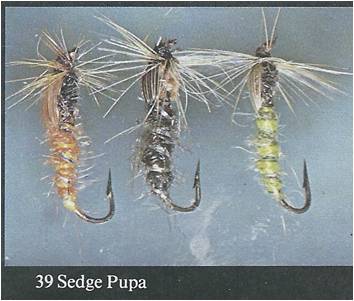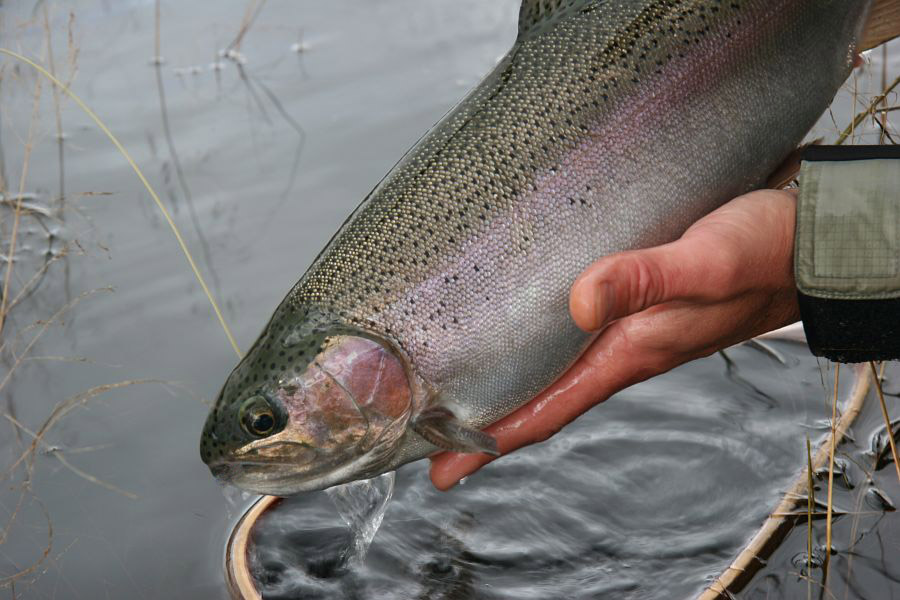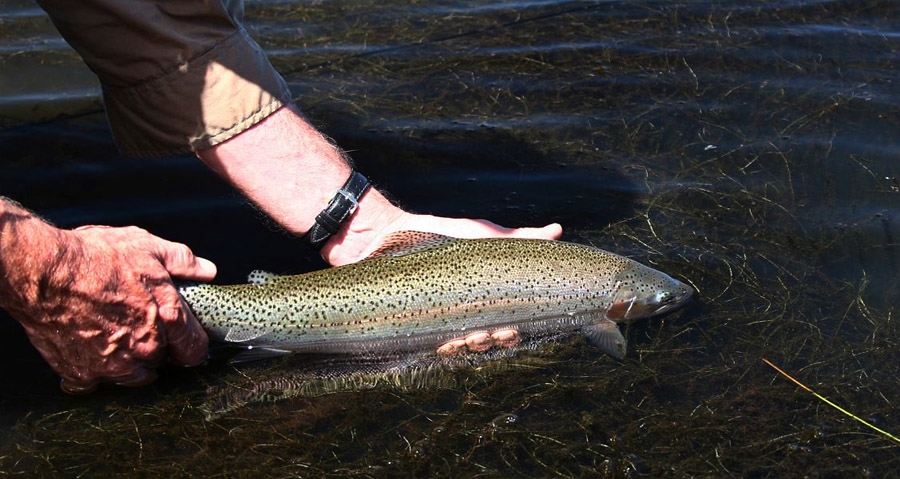Shortly after the close of the recent Dullstroom BONANZA, I was invited to fish on Millstream's ‘Solitary Reaper Dam’, which is renowned for its specimen fish. I relished this opportunity, because it was a dam of very mixed results during the BONANZA competition - delivering the biggest fish of the event, one or two other very large fish, yet proving very difficult for some anglers. But our competition's winner Franswa Venter took five fish there on the same afternoon that other very capable anglers blanked. So, yes, it qualifies as technically difficult water, with plenty of subsurface weed to think about - not unlike one or two other excellent waters that were included in the BONANZA. And for that reason I was keen to explore its potential without the pressure of other competitive anglers around me.
Click in images to enlarge
Having fished the water some time before, I knew that I needed only one line - a dull-colored 5 WT floater - and, more than likely, only one or two of the many fly boxes that one would normally carry into a competition. So, it was a limited selection of nymphs, pupa imitations, hatching patterns and a few nondescript dries - no large or heavy flies, no boobies, no attractors, no lures, regardless of how well these flies may often fish on other waters. I needed flies that could be cast lightly and easily, that had movement in their structure and that could be retrieved very, very slowly without sinking into weed. To cut an afternoon's story short, I enjoyed one of the finest fishing sessions that I have had in a long time. I eventually lost count of the fish that I hooked - but it was well over 15, with many more missed takes, and one or two 50cm plus fish brought to the net – but let's look at the afternoon’s story in a little more detail.
I kicked off by fishing in the near corner, with a light wind behind me, casting towards the drop-off where I could see the occasional rising fish - clear water (NO weed), but requiring a longish cast to get to the drop-off. I don't recall the fly, but it was likely to have been an un-weighted dragonfly nymph or damsel. Nothing doing there, but after a half-hour or so I noticed the occasional ‘bump’ or swirl in the margins just off the bank, between weed beds, somewhat further down the dam wall. Not rising fish, but moving fish - indicating feeding activity. So I moved - and having the wall to myself meant that I could be very choosy about where I moved to and I picked it carefully.
I selected a spot where I could stand at the base of the dam wall (so I was effectively concealed in front of the wall), the sun to my right and slightly ahead of me (no shadow in the fishing zone), fishing a relatively short cast (10 to 12 meters, with a minimum of false casts, generally only one cast), fishing diagonally down the bank (between the weed beds, not across them). My principal aim was to reach these fish, without disturbing them, and avoid conflict with the weed banks. I fished a relatively long leader (5 to 6 meters), not because I needed depth, but to avoid lining feeding fish, with a relatively fine tippet (6lbs) for the weedy conditions.

Image per Alan Hatton
And the fly? I got lucky with my second choice, which is an old favourite - a size 12 Goddard's Sedge Pupa, with chocolate brown abdomen, tan thorax and sparse ginger hackle – no bead head. The logic? Plenty of dark sedges flying around in the margins, but no signs of fish rising to hatching naturals - so I reckoned that I should just grub around with a very slow, twitchy figure-of-eight retrieve a few feet below the surface using a fly choice that was likely to look something like whatever was down there.
I was into fish immediately and it was evident that these were confidently feeding fish - firm, slow takes, that I could lift into gently without fear of breaking off. A few of the fish headed straight for the sub-surface weed. Remarkably, I lost none in the weed but there were a few dropped fish that I had to bully away from it. No worries - we weren't fishing for gold watches that afternoon! As I say, I lost count, but it didn't matter a jot - the intent was to find fish and work out how to catch them in technically tough conditions. The success was in every take and hook-up - not in the total count.

Interestingly, any changes to method or device proved fruitless. As an example, at one point there were a few typically splashy rises to what I assumed were hatching sedge, so I switched to a hatching pattern - no result. After a good number of fish, I noticed that my fly had become very messy with even a broken ribbing, so I tied on a fresh pattern, maybe a little larger in the body - no result. Speed up the retrieve - no result. Any switches to different fishing areas simply didn't deliver fish. But - same place, same retrieve, very same fly, then it was fish after fish after fish. And suddenly it all stopped in the dying light as the fish moved up everywhere to take hatching mayflies - those tiny, difficult, plentiful blighters that we all enjoy so much! But by then, I had enjoyed a wonderful, hectic, rewarding couple of hours of very relaxed fishing on a splendid water, so I was happy to walk away from it.

To conclude, it may be beneficial to summarise the lessons learned (or re-confirmed) that afternoon in the form of a few answers to the question ‘How do you catch fish on supposedly technically difficult waters when others are blanking with all the ‘proven’ methods?’ My suggestions (and few of them are rocket science!) would be:
Don’t fish long and blind!
First find the fish and get as close as you can, without being seen (In the absence of visible clues, fish where fish are likely to be)
In this connection, weed normally means food (and protection), which normally means fish
Visualize where, how, and on what the fish may be feeding - develop and trust your fishing instinct and abandon the temptation to do what ‘normally works’!
Select flies that represent the life form you are seeking to imitate - they are not necessarily the ‘best looking’ flies in the shop
Fish close, fine and quietly - avoid false casts and messy lift-offs
Slow down your retrieve - there is very little down there moves as fast as the ‘average’ retrieve
When you find what works - stick with it

Now, few of these tips will apply to the methods that you might exploit to catch fish with lures or attractor patterns in less technically difficult circumstances or when fishing blind - but in this instance those methods had already proved to be largely unsuccessful and what we were setting out to achieve was to find and catch fish when these methods are failing. Try it - you may be amazed how easy these so-called technically difficult waters can be become, when fished with a little thought!



